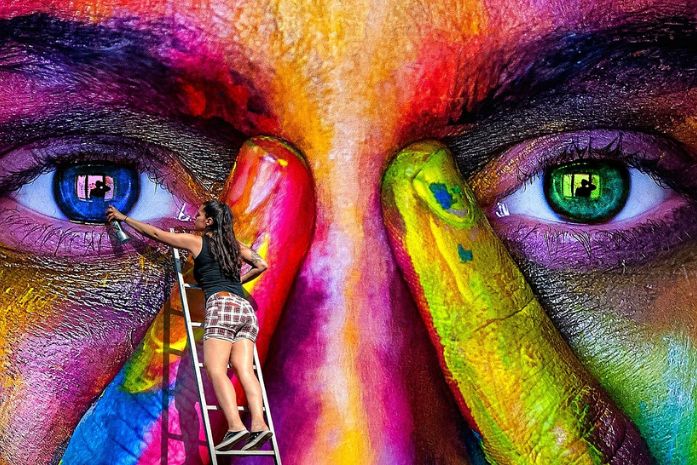Amazing Street Art
Posted on 23 Jul, 2024

Most of us will have seen graffiti but when does it become street art? This kind of dynamic art form can transform public areas into outdoor galleries. It includes a diverse range of creative expressions, from intricate paintings on building walls to interesting installations constructed from common objects. Unlike graffiti, which is typically marked by stylized lettering, it seeks to engage the audience with striking images and thought-provoking themes.
Beyond its visual impact, the rise of street art has also catalysed opportunities within the design industry. This dynamic art form not only enhances urban landscapes but also inspires careers for creatives seeking to merge urban aesthetics with innovative design solutions.
A historical canvas
Going back in history, street art originated with early human expression, as evidenced by Egyptian tomb markings and ancient cave paintings. Though not created with the same purpose as contemporary wall art, these early examples capture the human desire to make an impression and communicate visually in public places.
Moving forward to the 20th century, we witness the more recognisable emergence of contemporary public art. Public wall art increased in Philadelphia and New York City during the 1960s and 1970s. Leading artists like Jean-Michel Basquiat and Keith Haring brightly painted urban landscapes and injected them with social critique. This pivotal juncture established it as a potent voice for impoverished people and a venue for artistic opposition.
A Voice for the Streets
It is more than just a way to beautify public spaces; it can also be an effective tool for social and political criticism. Artists use symbols, images, and sometimes humour to express crucial societal issues. It is a strong tool for raising awareness and sparking discourse about a wide range of issues, including political injustices, environmental concerns, economic imbalance, and social inequality.
Its immediacy allows artists to avoid typical art world gatekeepers and interact directly with the general public. These bright murals serve as cues, encouraging viewers to confront hard realities or contemplate other viewpoints. It has the power to spark change by encouraging individuals and communities to take action and advocate for a better future.
Beyond Aesthetics: The Impact of Urban Art Design
Street art often goes beyond its visual appeal, generating a significant social influence. It has the ability to revitalise underserved urban areas while instilling a feeling of community pride and ownership. A well-placed mural may convert a dull concrete wall into a lively landmark, drawing tourists and creating a good atmosphere in the region. Increased foot traffic can help local businesses and inspire more artistic expression.
Furthermore, the increased incorporation of street art into urban contexts not only revitalises underutilised areas, but also creates a demand for competent designers. These artists make designs that are ecological and socially responsible, appealing to both local communities and worldwide audiences. Their work extends beyond simple aesthetics, contributing to a more lively and engaged urban experience.
A Beacon of Creativity
Street painters employ a range of mediums, from intricate mosaics and wheatpasting to more conventional stencilling and spray painting. Some artists create works that are in harmony with their surroundings by incorporating commonplace objects and materials. The fleeting nature of wall art contributes to its allure. Each piece, constantly at risk of removal or painting over, becomes a unique experience at a specific time and location. This impermanence can also spark debates about the value of public art, the fleeting nature of beauty, and the dynamic urban environment.
Evolving with the Times
New technologies regularly emerge, providing artists with inventive ways to engage with public spaces. Think about touch-sensitive interactive murals or augmented reality experiences that superimpose digital elements on real-world artwork. These advancements could lead to ever more captivating and immersive art encounters.
However, the increasing popularity of street art presents new challenges. There's a chance that gentrification and corporate support will push out independent artists and the unfiltered, rebellious energy that characterises street murals as the lines between art and commerce become increasingly blurred. The survival of this dynamic art form will depend on striking a balance between allowing it to flourish in the public eye and maintaining its rebellious beginnings.
From Streets to Interiors: The Unexpected Connection
The influence of this art can extend beyond outdoor spaces and into the realm of interiors. Homes, offices and public spaces can incorporate street art-inspired elements like stencils, murals, and textures.
This trend offers significant advantages, bringing personality and energy to otherwise sterile environments. By using sustainable materials and repurposed pieces, designers bridge the gap between the rebellious spirit of urban art and ethical design practices. This evolution not only enriches interior aesthetics but also opens up diverse career opportunities in the design industry, where professionals can innovate and create meaningful spaces inspired by street art.
We hope you have found this article interesting. Explore our design job opportunities and help shape the future of creative spaces!
Posted in: Designers
